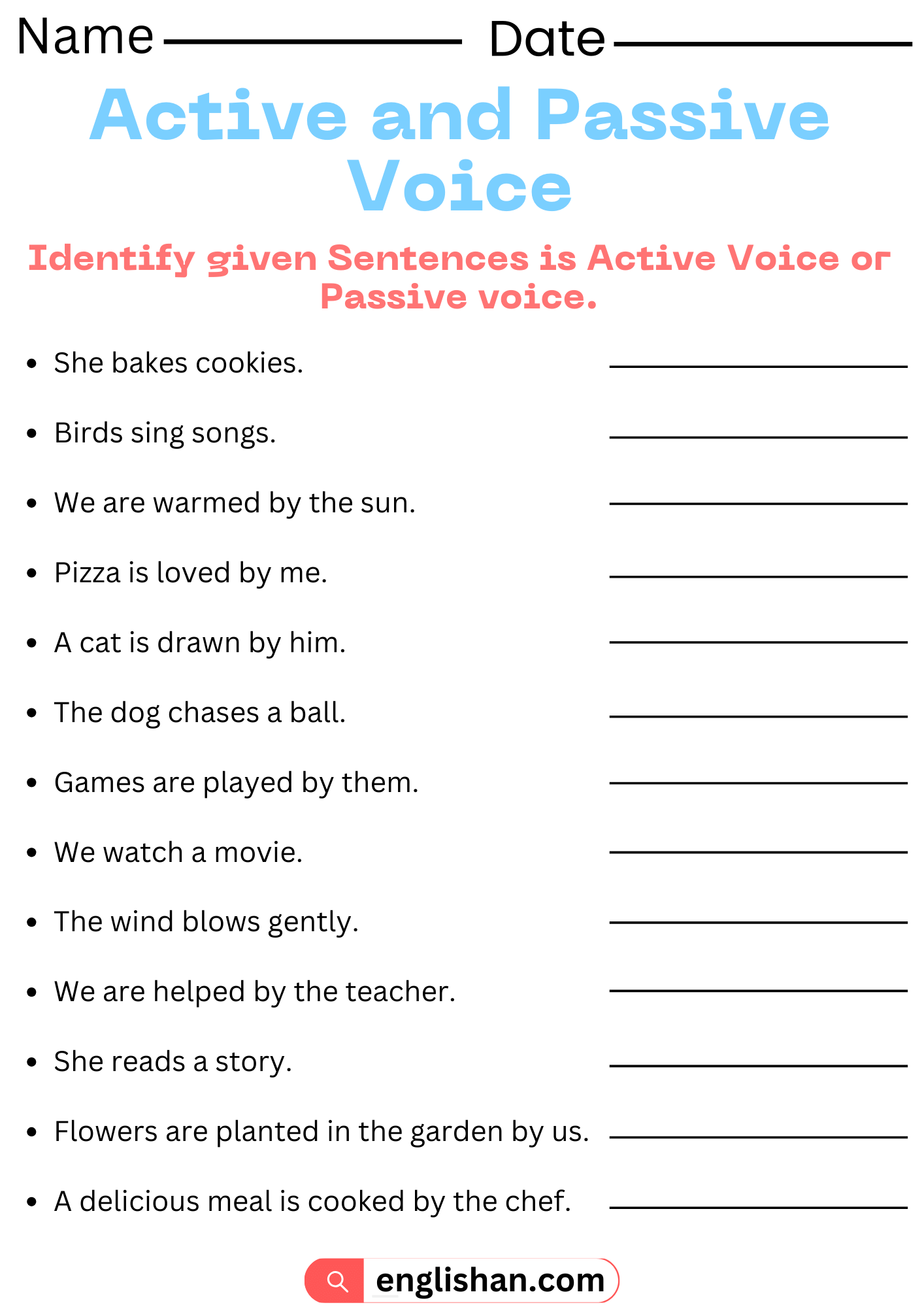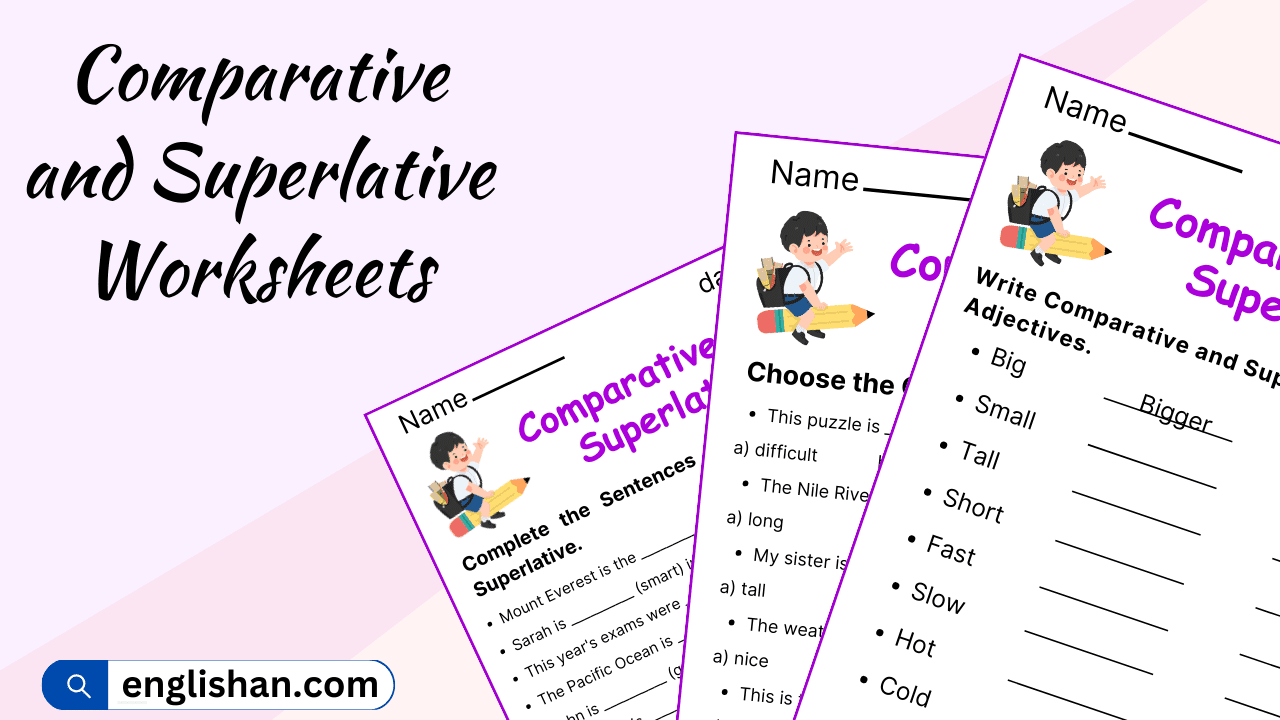Contents
Active and Passive Voice Worksheets are really useful for learning about different ways of making sentences in English. These worksheets help you understand how to change a sentence from active to passive, and vice versa. Using Active and Passive Voice Worksheets is great for anyone trying to get better at English. They teach you how to structure sentences in different ways. This is important for writing and speaking clearly. These worksheets are a big help in learning this important part of English grammar.
Active and Passive Voice Worksheets
Worksheet 1: Rewrite the Sentences in Passive Voice
Scroll down to See Answers

Worksheet 2: Identify given Sentences is Active Voice or Passive voice
- She bakes cookies.
- Birds sing songs.
- We are warmed by the sun.
- Pizza is loved by me.
- A cat is drawn by him.
- The dog chases a ball.
- Games are played by them.
- We watch a movie.
- The wind blows gently.
- We are helped by the teacher.
- She reads a story.
- Flowers are planted in the garden by us.
- A delicious meal is cooked by the chef.
- The cat catches a mouse.
- The kids build a sandcastle.
- I draw a picture.
- A bicycle is ridden by him.
- The rainwater fills the pond.
- A letter is written by her.
- The team wins the championship.
Scroll down to See Answers

Answer of Worksheet 1:
Answer of Worksheet 2:
- Active
- Active
- Passive
- Passive
- Passive
- Active
- Passive
- Active
- Active
- Passive
- Active
- Passive
- Passive
- Active
- Active
- Active
- Passive
- Active
- Passive
- Active
FAQs
Active voice and passive voice show how the action is described in a sentence:
1. Active voice: The subject does the action.
Example: The dog bit the ball.
(The dog is doing the action.)
2. Passive voice: The subject receives the action.
Example: The ball was bitten by the dog.
(The ball is receiving the action.)
In active voice, the subject is doing something, and in passive voice, the subject is having something done to it.
In active voice, the subject does the action.
Example: The dog bit the ball.
In passive voice, the subject receives the action.
Example: The ball was bitten by the dog.
Here are 5 simple rules for active and passive voice:
1. Switch Subject and Object: The object becomes the subject in passive voice.
Example: The dog bit the ball. → The ball was bitten by the dog.
2. Use “By”: You can add “by” to say who did the action.
Example: The cake was eaten by Sarah.
3. Keep the Same Tense: The tense stays the same when changing voices.
Example: She eats the cake. → The cake is eaten by her.
4. Only with Action Verbs: Only verbs that have an object can be made passive.
Example: She kicked the ball. → The ball was kicked by her.
5. Use Passive When Doer is Unimportant: Passive is used if we don’t need to say who did the action.
Example: The lesson was explained.
Here are 10 simple examples of active voice:
1. The cat chased the mouse.
2. Sarah reads a book.
3. The teacher explains the lesson.
4. I ate lunch.
5. The dog barked.
6. John played soccer.
7. The sun warms the earth.
8. They built a sandcastle.
9. The chef cooks dinner.
10. We watched a movie.
In active voice, the subject is doing the action.
Here are 10 simple examples of passive voice:
1. The mouse was chased by the cat.
2. A book is read by Sarah.
3. The lesson is explained by the teacher.
4. Lunch was eaten by me.
5. The dog was barked at.
6. Soccer was played by John.
7. The earth is warmed by the sun.
8. A sandcastle was built by them.
9. Dinner is cooked by the chef.
10. A movie was watched by us.
In passive voice, the subject receives the action.
You May Also Like






